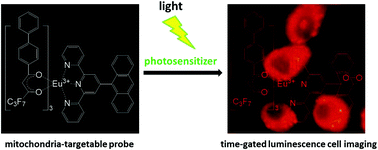Design of a β-diketonate–Eu3+ complex-based time-gated luminescence probe for visualizing mitochondrial singlet oxygen†
Abstract
Although molecular luminescent probes capable of detecting target analytes in an organelle of interest are especially appreciated, lanthanide complex-based organelle-targetable luminescent probes have rarely been developed. Herein, by using an anthryl-substituted terpyridine derivative, 4′-(9-anthryl)-2,2′:6′,2′′-terpyridine (ATPY), as a singlet oxygen (1O2)-recognition ligand, and a diphenyl-containing β-diketone coligand, 6-(1′,1′′-diphenyl-4′-yl)-1,1,1,2,2,3,3-heptafluoro-4,6-hexanedione (DHH), a new β-diketonate–Eu3+ complex-based luminescent probe, Eu(DHH)3(ATPY), has been designed and synthesized for the time-gated luminescence imaging detection of 1O2 in the mitochondria of living cells. The probe showed only weak luminescence due to the quenching effect of the 9-anthryl group. After the specific reaction of the 9-anthryl group with 1O2, the corresponding endoperoxide derivative that exhibited great quantum yield (Φ = 53%), Eu(DHH)3(EP-ATPY), was formed, accompanied by a remarkable luminescence enhancement. The luminescence response behaviors of Eu(DHH)3(ATPY) to 1O2 were investigated using two different 1O2 reaction systems in aqueous media. In addition, the time-gated luminescence imaging study has demonstrated the applicability of the probe for monitoring the 1O2 generation in 5-aminolevulinic acid (a drug for photodynamic therapy) loaded HepG2 cells with high sensitivity and selectivity. Furthermore, by coloading the probe and a mitochondrial indicator, Mito-Tracker Green, into HepG2 cells, the mitochondria-targetable feature of the probe has also been confirmed by confocal luminescence imaging measurements.



 Please wait while we load your content...
Please wait while we load your content...